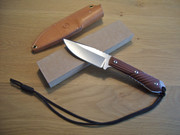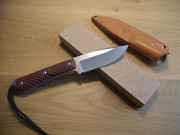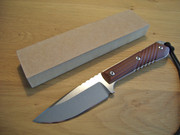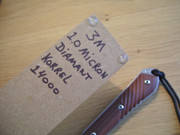This type of strop is what i sometimes make & give to people who regularly bring me a CRK or other quality (Chef-) knife for sharpening and/or some TLC, so they can maintain & keep the appearance of their new edge themselves for some time.
Even a few professional Chefs in my area with expensive gyuto's and santoku's in modern PM steel types are using these same strops with good results, so they keep telling me anyway.
I use them myself as well, and they are easy to make.
It's a new & cut-to-size piece of clean MDF coated with a thin layer of 1.0 micron (+/- 14000 grit) mono-diamond compound, and i put 4 self-adhesive rubber bumpers on the bottom.
These bumpers make the strop non-slip plus they elevate the working surface a bit more which makes the strop more convenient to use on a table (more room for your hands)
Due to the harder surface the chances of rounding your crisp apex are also greatly diminished when compared to stropping on compressible materials like leather.
The strop surface can also be cleaned from time to time with a microfiber cloth and some acetone, which will remove all or most of the swarf without removing the diamond particles, as these become (partially) embedded in the MDF surface during the stropping proces.
But this is (literally) the key element: the placement on rubber bumpers also provides the strop user with acoustic feedback by isolating the MDF from the table (a bit like the bars on a xylophone); you can actually hear when you're arriving at the very apex during stropping movements as the audible sound changes, which makes the stropping proces very easy, even for absolute beginners.
The CRK Nyala used as a prop for the pictures was reprofiled (from 35-40 degrees inclusive to an even 30 degrees inclusive) & sharpened (with 15 micron diamond compound on a Paper Wheel).
The owner only uses this quite expensive knife to cut oranges, about 5 each day, i kid you not,





Even a few professional Chefs in my area with expensive gyuto's and santoku's in modern PM steel types are using these same strops with good results, so they keep telling me anyway.
I use them myself as well, and they are easy to make.
It's a new & cut-to-size piece of clean MDF coated with a thin layer of 1.0 micron (+/- 14000 grit) mono-diamond compound, and i put 4 self-adhesive rubber bumpers on the bottom.
These bumpers make the strop non-slip plus they elevate the working surface a bit more which makes the strop more convenient to use on a table (more room for your hands)
Due to the harder surface the chances of rounding your crisp apex are also greatly diminished when compared to stropping on compressible materials like leather.
The strop surface can also be cleaned from time to time with a microfiber cloth and some acetone, which will remove all or most of the swarf without removing the diamond particles, as these become (partially) embedded in the MDF surface during the stropping proces.
But this is (literally) the key element: the placement on rubber bumpers also provides the strop user with acoustic feedback by isolating the MDF from the table (a bit like the bars on a xylophone); you can actually hear when you're arriving at the very apex during stropping movements as the audible sound changes, which makes the stropping proces very easy, even for absolute beginners.
The CRK Nyala used as a prop for the pictures was reprofiled (from 35-40 degrees inclusive to an even 30 degrees inclusive) & sharpened (with 15 micron diamond compound on a Paper Wheel).
The owner only uses this quite expensive knife to cut oranges, about 5 each day, i kid you not,






Last edited:


